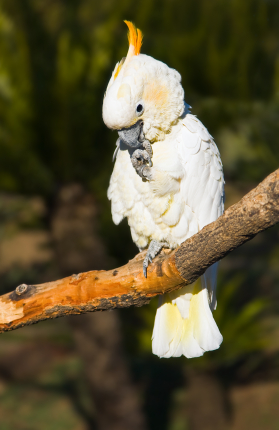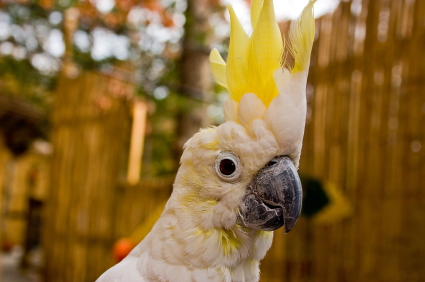Cacatua galerita, the Sulphur Crested Cockatoo Genus, Cacatua is native to Australia and can be found from Far North Queensland along the west coast all the way to just north of Perth.
Australians consider them pests as they can be destructive to crops and homes. Farmers are often given permits to destroy them. Sulfur-crested Cockatoos breed from August to January in the south of their range, and May to September in the north. They generally lay one to three eggs and both male and female birds prepare the nest and care for the birds. Chicks hatch after about 30 days and become independent around 60 to 70 days. However, they remain with the parents year-round, and family groups generally stay together indefinitely.

There are four subspecies of Sulphur Crested including the Eleonora cockatoo, Medium Sulphur Crested cockatoo, and Triton cockatoo. The Greater Sulphur-crested Cockatoo is a full-sized cockatoo, which means they grow to about 19 inches long.
Their plumage is fine and soft and they are primarily white with a yellow sulfur-colored crest on the top of their head. The underside of the wings and tail are also frequently tinged with yellow. Their eyes generally have blue skin around them and the iris is dark brown in males and reddish brown in females. Surgical or DNA sexing is generally required.
The Greater Sulphur-crested Cockatoo resembles the Lesser Sulphur-crested Cockatoo yet it is a different species. The Greater and Lesser Sulphur Crested are considered ‘superspecies’, which means they are similar species that are geographically separated.
The Lesser is native to Timor-Leste and Indonesia’s islands of Bali, Timor, Sulawesi, and the Lesser Sunda Islands. The Greater Sulphur is a larger bird than the Lesser and the lesser Sulphur-crested Cockatoo has a stockier beak, a narrower crest, and white skin around their eyes rather than blue.
Typical of cockatoos, the Sulphur Crested Cockatoo is an incredibly affectionate and intelligent bird. In the wild Cockatoos are friendly and peaceful. They live together in flocks of 20 or more birds. In captivity, they are affectionate and loyal and can be taught a number of tricks.
They are considered to be moderate talkers with the ability to generally learn a handful of words. In addition to their intelligence, they are considered extremely noisy birds and are not the right bird for an owner in a small space or with shared walls. Likewise, they demand a significant amount of personal attention each day.
Potential drawbacks to ownership are their need for attention, their natural tendency to chew on almost everything, and their extremely loud nature. They’re extremely vocal and regular vocalizations and screeching are heard both in the morning and in the
Sulphur-Crested Cockatoo Lifespan
While the Sulphur Crested Cockatoo generally only live 20-40 years in the wild, in captivity they are extremely long-lived and can live upwards of 70 years. This longevity means that people considering owning a Sulphur Crested Cockatoo must take into consideration proper socialization, training, and care to ensure that they live a long and happy life. Proper socialization, training, and care will also help to eliminate any behavior problems and the potential need for re-homing.

Sulphur Crested Cockatoo Appearance
Greater Sulphur-crested Cockatoos are full-sized cockatoos which means they’re big. They can and do grow to about 19 inches long and are considered among the largest cockatoos. Their feathers are white like a traditional cockatoo yet they have a bright yellow crest.
The underside of their wings and tails are also tinged with yellow. Their eyes are rimmed with blue skin and the iris of a male is dark brown while the iris of a female is reddish brown. But don’t go looking into the eyes of a cockatoo to determine if it is a male or female, experts recommend surgical or DNA sexing.
Sulphur Crested Cockatoo Behavior
Typical of Cockatoos, the Sulphur Crested Cockatoo is an extremely affectionate and intelligent bird. They generally bond very strongly with one owner and caregiver and will shower this person with tons of affection.
While there are always exceptions to the rule, they generally enjoy being petted, snuggled, and basically considered one of the family. If you are looking for a devoted friend and lifelong companion, the Sulphur Crested Cockatoo may be the ideal bird for you.
Remember, that in order to receive affection, you must be able to give it – particularly where the Sulphur Crested is concerned. Your Sulphur Crested needs a large amount of your time each day. This time can be spent hanging out, playing, bonding, and trick training.
They’re incredibly intelligent and trick training is usually the key to a strong bond of trust and a well-behaved cockatoo. If you’re unable to spend a significant amount of time with your Sulphur Crested, you will have an unhappy bird and the potential for some very bad behavior problems.
Speaking of which…
Sulphur Crested Cockatoo Common Health and Behavior Problems
I’m just going to come out and say it because there is no way around it and not mention it would do you and your future Sulphur Crested Cockatoo a disservice. Sulphur Crested Cockatoos are loud. I don’t mean they make a bit of noise – they’re loud!
They enjoy making an enthusiastic ruckus in the morning when your neighbors really appreciate it, and they love to make a ruckus in the evening. It’s just their way of enjoying life. So, if you don’t want a noisy bird or you and/or your neighbors can’t handle the noise please don’t get a Sulphur Crested Cockatoo.
Now, having made it clear that they are noisy it must also be said that if your Sulphur Crested is screaming all day long, something’s wrong. Generally, there are a few causes of bad behavior which include screaming, biting, and feather plucking, and they all evolve around the bird not living in an optimal environment.
Stress, jealousy, boredom, illness, too small of a cage, not enough entertainment, fear, and other issues can cause behavior problems. Each one is addressed with a modification of the environment, plenty of training, and an abundance of patience and positive reinforcement.
Sulfur-crested Cockatoos are also susceptible to a widespread viral disease known as Psittacine Beak and Feather Disease, which causes the birds to lose their feathers and grow misshaped beaks. They’re also susceptible to parasites, intestinal inflammation, coccidiosis, and respiratory ailments.
Sulphur Crested Cockatoo Caging and Feeding
Due to their very large size and desire for space to move around, a large cage is required (minimum 2 ft. x 2 ft. x 3 ft. high) unless you are able to leave your bird outside of their cage for long periods of time each day.
A pen or a perch works well outside of the cage. They require an abundance of toys to keep their minds and their beaks busy, to leave them without toys is just asking for destruction and unhappiness. In captivity, they will enjoy and thrive on a pellet-based diet, daily fresh fruits and vegetables, and treats of seeds and nuts.
The Sulphur Crested Cockatoo is a wonderful bird if you have the time and desire to care for them the way they demand and deserved to be cared for. If you’re looking for a quiet bird that doesn’t require your time and attention 24/7 then keep looking, the Sulphur Crested isn’t for you.
If however, you want a bird that will love you almost unconditionally, play with you, learn tricks, talk to you, and entertain you 24/7 then the Sulphur Crested may be exactly what you’re looking for.
